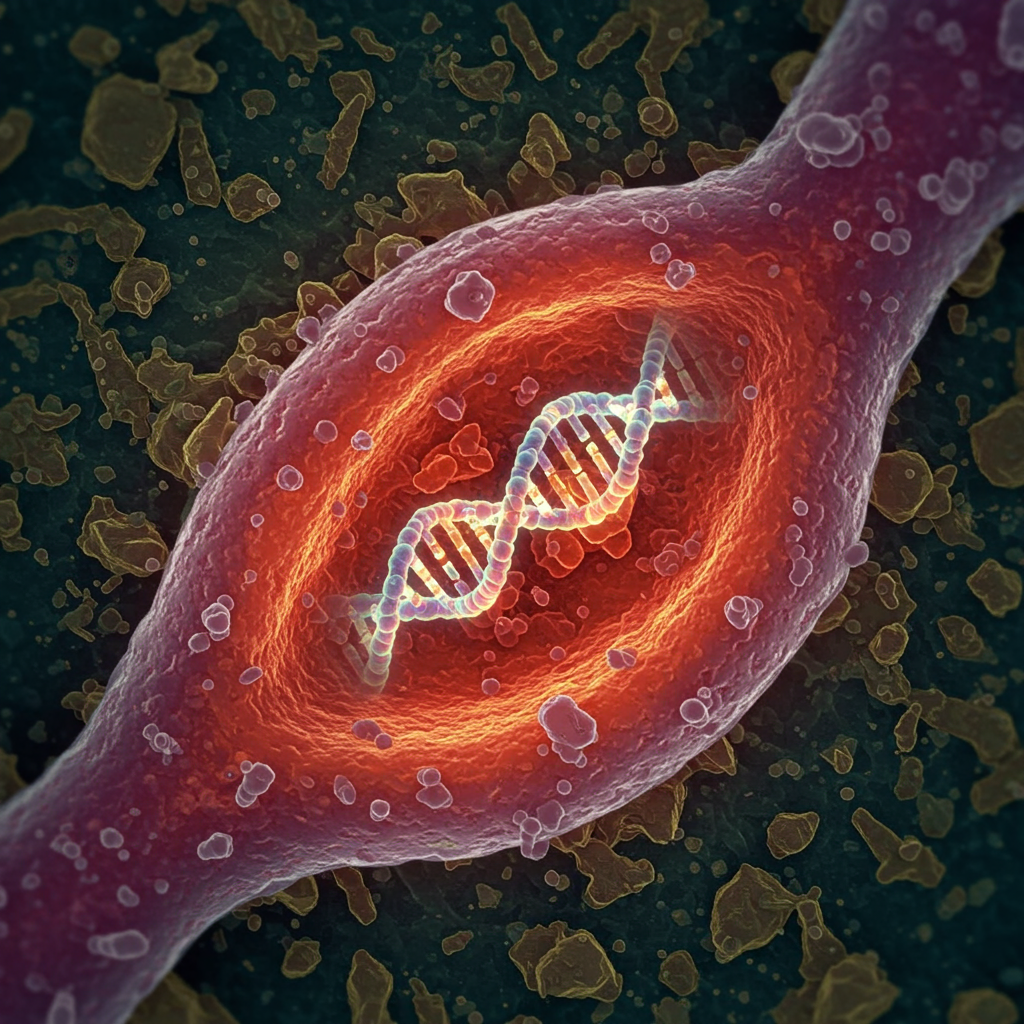Imagine a silent, invisible threat swirling around us daily, capable of altering our very DNA and dramatically increasing the risk of a deadly disease. Recent groundbreaking research confirms that air pollution lung cancer is a profound public health crisis, capable of steering healthy lung cells toward malignancy, even in individuals who have never smoked. This discovery profoundly reshapes our understanding of lung cancer, long primarily associated with tobacco, revealing that environmental factors now play a critical, often overlooked, role.
This comprehensive guide delves into the startling scientific evidence connecting airborne pollutants to DNA damage and tumor development. We’ll explore how microscopic particles mimic the harmful effects of tobacco smoke, detail the specific genetic changes observed, and discuss the global implications for public health. Understanding these mechanisms is crucial for prevention and for advocating for cleaner air.
Unmasking the Genomic Threat: How Pollution Alters DNA
Scientists have long suspected a link between dirty air and respiratory illnesses. However, a pivotal study published in Nature on July 2, 2025, provides compelling evidence of how exactly air pollution lung cancer develops at a cellular level. Researchers, including cancer geneticist Ludmil Alexandrov from the University of California, San Diego, revealed that inhaling pollutants can inflict DNA damage strikingly similar to that caused by tobacco smoke. This research offers a strong argument for prioritizing air quality.
Their team discovered that people residing in highly polluted areas accumulate significant DNA glitches. These genetic errors can directly trigger lung cancer. Crucially, these mutations can cripple the very genes designed to protect cells from cancerous growth, such as TP53. The discovery that air pollution can directly mutate DNA, particularly tumor-suppressing genes, highlights its insidious nature.
The Rising Tide of Non-Smoker Lung Cancer
Historically, lung cancer has been synonymous with smoking. While tobacco remains the leading cause, an alarming trend is reshaping its epidemiology: lung cancer is increasingly diagnosed in individuals who have never smoked. Up to 25 percent of all lung cancer cases now occur in this non-smoking demographic. Experts attribute this shift to two main factors: a global decline in smoking rates and a concurrent, pervasive rise in air pollution lung cancer risk.
Data from the Global Cancer Observatory 2022, analyzed by researchers from the International Agency for Research on Cancer (IARC) and the World Health Organization (WHO), underscores this change. Adenocarcinoma, a type of cancer that forms in mucus-producing glands, now represents the most common form of lung cancer globally. Significantly, among never-smokers, adenocarcinoma accounted for 53-70% of lung cancer cases in 2022. Unlike other subtypes, adenocarcinoma shows a weaker correlation with cigarette smoking, strongly implicating other environmental factors like air pollution.
Global Impact and Geographic Disparities
The global burden of lung cancer is staggering. Approximately 2.5 million new cases are diagnosed annually worldwide, a figure predicted to surge to over 4.5 million by 2050. Lung cancer remains the leading cause of cancer-related deaths across the globe. For non-smokers, it has tragically become the fifth leading global cause of cancer-related mortality.
To investigate how DNA mutations contribute to this rise, Alexandrov’s team, in collaboration with the National Cancer Institute, analyzed lung cancer DNA from nearly 900 “never smokers.” They estimated each participant’s overall air pollution exposure based on their residential location at diagnosis. The findings were stark: lung cancers from people living in heavily polluted metropolises like Milan and New York City exhibited substantially more mutations compared to those from rural areas. This mutation overload can wreak genetic havoc within cells.
The prevalence of non-smoker lung cancer is notably higher among women and Asian populations, almost always presenting as adenocarcinoma. In 2022, an estimated 908,630 new lung cancer cases were recorded among women globally. A significant portion of these, 541,971 (59.7%), were identified as adenocarcinoma, with 80,378 directly linked to particulate matter (PM) air pollution. These statistics paint a clear picture of air pollution’s devastating and disproportionate impact.
The Silent Threat: Microscopic Particles and Chemical Carcinogens
Microscopic particles of dust, soot, and various chemicals found in polluted air are the culprits. When inhaled, these tiny invaders can penetrate deep into the lungs. They don’t just irritate tissues; they actively trigger changes at the DNA level. Inside every human cell, our genome, the genetic instruction book of life, comprises some six billion DNA letters. Mutating too many of these letters can “garble the book’s text,” disrupting vital tumor-fighting genes like TP53.
The researchers identified TP53 as one of the key genes mutated in patients from high-pollution zones. Remarkably, these patients exhibited many of the same genetic mutations seen in heavy smokers, reinforcing the idea that both tobacco smoke and air pollution harm DNA through similar pathways. This suggests that the environmental factors of urban smog can be as damaging to our genetic blueprint as direct exposure to cigarette smoke.
Protecting Lung Health: Actionable Steps and Collective Responsibility
The World Health Organization reported that as of 2019, nearly the entire global population lives in areas that fail to meet their air quality standards. This widespread exposure means billions inhale harmful pollutants daily, elevating their risk of developing lung cancer even without a smoking history. This makes air pollution a silent but deadly threat that demands both individual awareness and collective action.
Individuals can take proactive steps to reduce their exposure to environmental carcinogens. These include:
Avoiding High-Pollution Areas: Limit time outdoors during peak pollution alerts or heavy traffic.
Using Home Air Purifiers: High-efficiency particulate air (HEPA) filters can significantly reduce indoor air pollutants.
Wearing Masks: High-filtration masks (e.g., N95) can offer protection in severely polluted environments.
Beyond individual measures, safeguarding lung health requires broader community and global initiatives. Supporting clean energy policies, advocating for stricter emissions regulations, and promoting sustainable urban planning are crucial steps. These public health strategies aim to reduce overall air pollution, ensuring cleaner air for everyone.
Research also suggests that maintaining strong physical fitness can positively influence outcomes for cancer patients. A British Medical Journal* study found a link between high muscle strength and cardiorespiratory fitness and a lower risk of all-cause mortality. Dr. Reshma Puranik, a Consultant Medical Oncologist, notes that resilient muscles and functional lungs can decrease mortality risk in cancer patients by 11%. While not a preventative measure against pollution-induced cancer, it highlights the importance of overall health.
Frequently Asked Questions
How does air pollution cause lung cancer at a cellular level?
Air pollution triggers lung cancer by introducing microscopic particulate matter and chemicals into the respiratory system. These pollutants lead to DNA damage, causing mutations in lung cells. Specifically, they can alter tumor-suppressor genes like TP53, which are crucial for preventing abnormal cell growth. This process of genetic mutation is strikingly similar to the damage caused by tobacco smoke, enabling uncontrolled cell division that leads to tumor formation, even in non-smokers.
What steps can individuals take to reduce their risk from air pollution?
To mitigate the risk of air pollution lung cancer, individuals can take several practical steps. These include monitoring local air quality reports and avoiding outdoor activities during high pollution days. Utilizing home air purifiers equipped with HEPA filters can significantly improve indoor air quality. Wearing high-filtration masks, such as N95 respirators, in heavily polluted environments also offers protection. Additionally, advocating for and supporting clean energy policies and urban planning initiatives that reduce emissions contributes to broader community protection.
Is lung cancer among non-smokers becoming more common?
Yes, lung cancer among non-smokers is increasingly common and is now considered the fifth leading global cause of cancer-related deaths. While smoking remains the primary driver of lung cancer, a significant percentage (up to 25%) of cases now occur in individuals who have never smoked. This rise is partly due to decreasing global smoking rates but primarily linked to increased exposure to environmental factors, especially air pollution. Adenocarcinoma, a specific subtype of lung cancer, is particularly prevalent in non-smokers, especially among women and Asian populations.
A Shared Responsibility for Cleaner Air
The evidence is clear: air pollution lung cancer is a growing concern that transcends traditional risk factors. As scientists continue to explore how various exposures, including vaping, might alter our genomes, the urgency to address environmental pollution intensifies. Unlike personal choices, air quality is a shared responsibility. Protecting our lungs, and the lungs of future generations, demands a concerted effort from individuals, communities, and policymakers to champion cleaner air and healthier environments. This critical period calls for increased awareness and decisive action to mitigate this pervasive, yet often overlooked, health threat.




